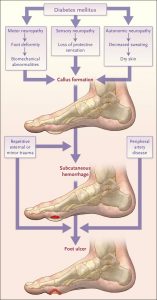Diabetic foot disease is one of the most common, serious, feared and costly complications of diabetes. People with diabetes are at a 15 to 40 fold higher risk of a lower limb amputation than a non-diabetic person. 80% of lower limb amputations in diabetes are preceded by the development of a foot ulcer. It is estimated that the annual incidence of lower limb ulceration in people with diabetes varies between 2.2% to 7%. Diabetic foot disease is costly, with people frequently requiring admission to hospital, investigations, surgery and a prolonged hospital stay.
In order to look after your feet, you should follow these general rules:
- Nail Care – check up with chiropodist monthly.
- Footwear well fitting.
- Daily self-examination of the feet checking for changes or breaks in the skin.
- Never ever walk inside/outside in bare feet
- Checking your footwear and socks/hosiery before putting them on to ensure all is in good order.
- Check bath and shower temperatures to avoid scalding.
- Avoid home remedies e.g. corn plasters etc

As diabetes develops our feet become less sensitive. One may be inclined to wear tight fitting shoes, but this is never a good idea. Never buy off the shelf shoes with the thinking you will “break them in”.
Remember : Improper or poorly fitting shoes are major contributors to diabetes foot ulcerations.
If your are in any doubt, please do not hesitate to contact us at 01 443 4409 to book an appointment – do not use that old Irish euphemism, “it will be grand”
What we will do
- Check/Examine the feet We will check the feet for sensitivity, note any forms of structural foot deformity e.g Bunions, Toe deformities e.g. clawing toes, crossover toes, hammer toes, High Arch foot or Char cot Foot
- Recommend/Supply the correct footwear specific to diabetes ensuring the correct size and shape to wear to suit your feet
- Make alterations to accommodate deformities if necessary
- Fit the correct orthotics to suit your feet and the shoes. Offloading in the event of current or previous ulcerations.
- In the event that your foot is in the High Risk Zone we would refer you back to your Endcrinologist for their opinion, before proceeding to make bespoke footwear with materials specially designed for the diabetic foot.

 diabetes headline
diabetes headline